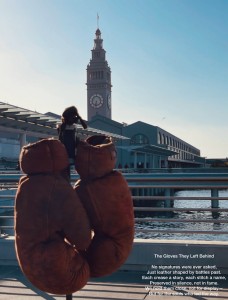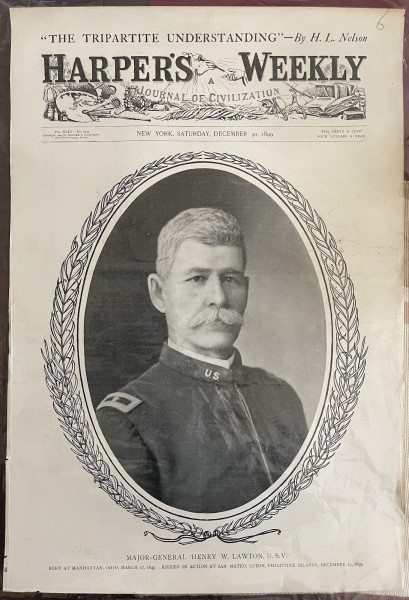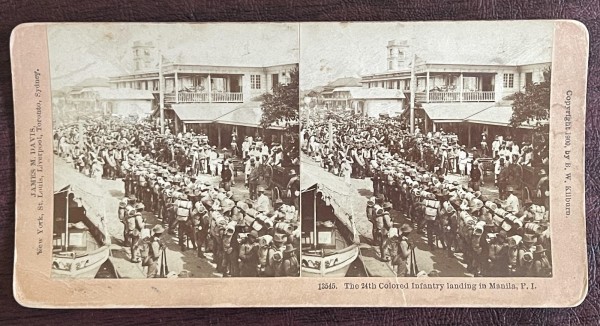
|
Philippines, 24 Dec 2025 |
Home >> News |
 |
||||
|
|
|
|
Levinson’s Gift: Runyon’s quiet revelation, Lawton’s last battle, and the first Filipino boxer By Emmanuel Rivera, RRT PhilBoxing.com Sat, 23 Aug 2025  Before the world ever heard the name of Filipino champions like Pancho Villa, Small Montana, Little Dado or Ceferino Garcia there was a beginning no one talks about. It didn’t happen in a boxing ring. It happened in the mud, in the rain, in the aftermath of war. A pair of gloves— worn, military-issue, stamped with the name Levinson— was left behind in the rice fields of San Mateo, now named Morong, Rizal province in the Philippines. Not a weapon. Not a prize. Just two tools of battle and rhythm. In his earlier wartime reporting, Damon Runyon— known more for his Broadway tales, incisive reportage, and ringside color— penned a landmark piece about a historic discovery following the Battle of San Mateo (now Morong, Rizal). 
Source: Harper’s Weekly, NEW YORK, SATURDAY, DECEMBER 30, 1899 (Public Domain) U.S. Army soldiers, led by Major-General Henry Ware Lawton against the insurgent Filipinos led by Glicerio Geronimo, he recalled, found something unexpected among the gear left behind by fleeing Filipino revolutionaries— a pair of boxing gloves. Not just any gloves. These bore the imprint of an American Solomon Levinson, the glove maker of Market Street in San Francisco. And according to Runyon, they weren’t simply lost supplies— they were proof of something remarkable…that a renegade soldier from the 24th Infantry, a Black American, had stayed behind and begun teaching Filipinos how to box. It wasn’t part of any military campaign. It was something else— something offered freely. This quiet, subversive act— one soldier, one pair of gloves— may have marked the earliest moment when the sport of boxing took root in the Philippines. (Source: Wilkes-Barre Times Leader, the Evening News (Wilkes-Barre, Pennsylvania) • Fri, Oct 9, 1925 • Page 16— now copyright free) Years later, Runyon would revisit the story in a second column, this time reflecting on a young Filipino featherweight named Johnny Hill, a boxer of Filipino and American descent, whose presence in the ring reminded him of that earlier memory. Hill was managed by Frank Churchill, the same man who would later help guide Pancho Villa’s career. But to Runyon, Hill was something else— a reminder of the mystery from San Mateo, a possible link to the soldier who disappeared but left behind something greater than himself. In fact, Runyon noted a curious twist; Frank Churchill, later celebrated as the Father of Philippine Boxing and founder of the legendary Olympic Stadium— the cauldron where Filipino boxing would truly ignite— had once claimed he was the first to introduce boxing to Filipinos during his military service. But the gloves from San Mateo told a quieter and different story. Churchill’s contributions were monumental and lasting. He would go on to shape the sport, guide champions like Pancho Villa, and build the stage upon which The Thirty would rise. 
Photo: Disembarking American troops, The 24th Colored Infantry landing in Manila (circa 1888-89), H.W. Kilburn, 1900 (Public Domain) Still, even Churchill may have unknowingly followed the footsteps of another— a nameless Black soldier from the 24th Infantry, who left behind a pair of Levinson gloves and, with them, the first spark that ignited the sport of boxing in the Philippine Islands. (Source: Damon Runyon,Star Tribune (Minneapolis, Minnesota) • Tue, Aug 10, 1926 • Page 15 The second column included testimony from Fred M. Short, a veteran of the 21st Infantry, who had read Runyon’s first article and confirmed its details. Mr. Short recalled the area near Marquina Road, where prisoners admitted that yes, they had learned to box from a Black American soldier. A teacher. A giver. It wasn’t much. A gesture. A lesson. A glove left behind. But sometimes history begins that way. Not with a title bout. But with a moment of memory. As if something was passed down, noit in words, but in movement. The next pages reprint both of Runyon’s columns in full, followed by the original Harper’s Weekly battlefield report on General Henry Ware Lawton’s final campaign. You’ll read of the downpour, the sudden rifle crack, the muddy fields where Lawton fell— shot through the chest beneath a wide-brimmed hat, said to resemble the one he wore in the Civil War. That is the official history. But this— what the gloves left behind— might be something more. They are what the soldier gave. They are what the Filipino boy picked up. They are the quiet beginning of something we would later call Filipino boxing. So let these three pieces be read with reverence. Not just for the fallen. But for the risen. For the anonymous Yankee soldier who chose to teach. For the unnamed Filipino boy who chose to learn. For the early spark that would one day light the path for Guilledo, Cabanela, Gan, Zapanta, Garcia and all pioneer Pinoy greats— The Thirty boxers— we honor in this book. Sometimes history doesn’t knock. It just leaves something behind— a pair of gloves, a beginning. And in Filipino hands, they thundered. Sources, References and Acknowledgements: • Photo: Disembarking American troops, The 24th Colored Infantry landing in Manila (circa 1888-89), By H.W. Kilburn, 1900, Public Domain • Harper’s Weekly Magazine, Photo of Major-General Henry Ware Lawton, U.S.V. (NEW YORK, SATURDAY, DECEMBER 30, 1899 (Public Domain) • Banner photo of original 1915-1925 Model of Sol Levinson Gloves (from the collection of the Philippine Boxing Historical Society and Hall of Fame) • Wilkes-Barre Times Leader, the Evening News (Wilkes-Barre, Pennsylvania) • Fri, Oct 9, 1925 • Page 16– Public Domain) • Damon Runyon,Star Tribune (Minneapolis, Minnesota) • Tue, Aug 10, 1926 • Page 15– Public Domain • This article contains selected excerpts, quotations, images, and archival references used under the Fair Use provisions of Section 107 of the United States Copyright Act. These materials are presented for educational, scholarly, and cultural preservation purposes. Every effort has been made to properly attribute sources and limit use to what is necessary to honor the historical and cultural narrative. Click here to view a list of other articles written by Emmanuel Rivera, RRT. |
|
|
PhilBoxing.com has been created to support every aspiring Filipino boxer and the Philippine boxing scene in general. Please send comments to feedback@philboxing.com |
PRIVATE POLICY | LEGAL DISCLAIMER
developed and maintained by dong secuya © 2025 philboxing.com. |